归化与异化英文论文
汉英翻译中的归化与异化分析
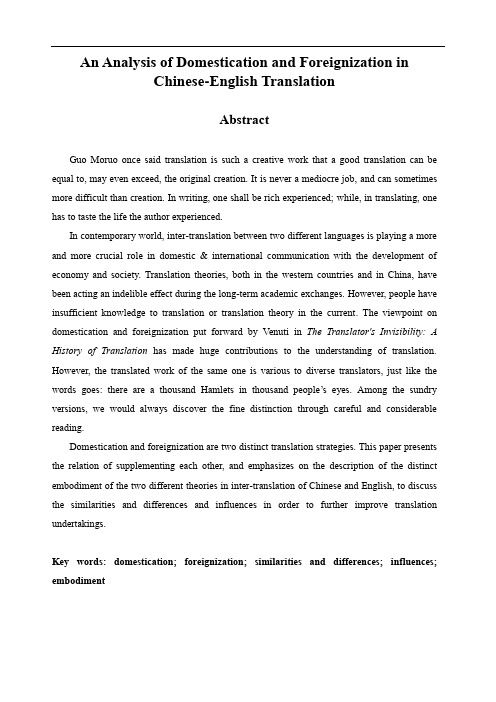
An Analysis of Domestication and Foreignization inChinese-English TranslationAbstractGuo Moruo once said translation is such a creative work that a good translation can be equal to, may even exceed, the original creation. It is never a mediocre job, and can sometimes more difficult than creation. In writing, one shall be rich experienced; while, in translating, one has to taste the life the author experienced.In contemporary world, inter-translation between two different languages is playing a more and more crucial role in domestic & international communication with the development of economy and society. Translation theories, both in the western countries and in China, have been acting an indelible effect during the long-term academic exchanges. However, people have insufficient knowledge to translation or translation theory in the current. The viewpoint on domestication and foreignization put forward by Venuti in The Translator's Invisibility: A History of Translation has made huge contributions to the understanding of translation. However, the translated work of the same one is various to diverse translators, just like the words goes: there are a thousand Hamlets in thousand people’s eyes. Among the sundry versions, we would always discover the fine distinction through careful and considerable reading.Domestication and foreignization are two distinct translation strategies. This paper presents the relation of supplementing each other, and emphasizes on the description of the distinct embodiment of the two different theories in inter-translation of Chinese and English, to discuss the similarities and differences and influences in order to further improve translation undertakings.Key words: domestication; foreignization; similarities and differences; influences; embodiment摘要郭沫若先生曾说:翻译是一种创造性工作,好的翻译等于创作,甚至还可能超过创作。
广告翻译中归化与异化策略的运用研究范文2篇
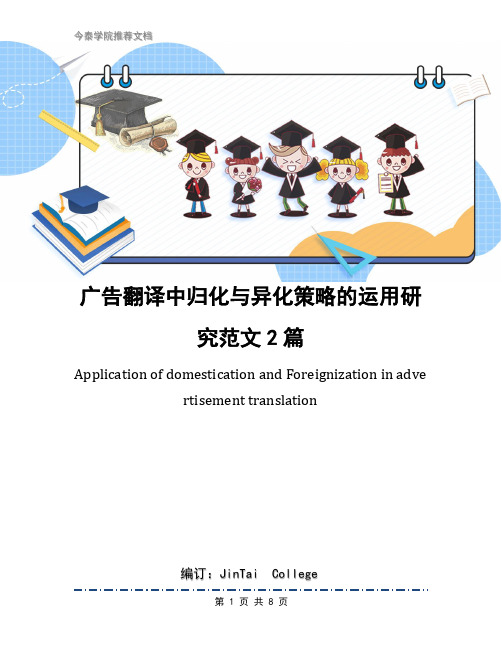
广告翻译中归化与异化策略的运用研究范文2篇Application of domestication and Foreignization in advertisement translation编订:JinTai College广告翻译中归化与异化策略的运用研究范文2篇前言:毕业论文是普通中等专业学校、高等专科学校、本科院校、高等教育自学考试本科及研究生学历专业教育学业的最后一个环节,为对本专业学生集中进行科学研究训练而要求学生在毕业前总结性独立作业、撰写的论文。
本文档根据毕业论文内容要求和特点展开说明,具有实践指导意义,便于学习和使用,本文下载后内容可随意调整修改及打印。
本文简要目录如下:【下载该文档后使用Word打开,按住键盘Ctrl键且鼠标单击目录内容即可跳转到对应篇章】1、篇章1:广告翻译中归化与异化策略的运用研究范文2、篇章2:舌尖上的中国英译中归化和异化翻译策略运用范文篇章1:广告翻译中归化与异化策略的运用研究范文成功的使用规划策略能让产品更好的融入到译入语的当地文化中,从而获得目标消费群体的认同。
本文着重分析了归化(domestication)和异化(foreignization)两种策略在中英广告翻译中的运用。
182017年,德国语言学家、翻译理论家施莱尔马赫(schleiermacher)指出,“有两种翻译方法:译者要么尽可能不去打扰作者,而让读者向作者靠拢;要么尽可能不去打扰读者,而让作者向读者靠拢”。
施莱尔马赫只是提出了这样一种说法,并没有为其命名。
而归化(domestication or adaptation)和异化(foreignization or alienation)这对翻译术语是由美国著名翻译理论学家劳伦斯韦努蒂(lawrence venuti)于1995年在《译者的隐身》中提出来的。
他指出,归化是要把源语本土化,以目标语或译文读者为归宿,要求译者将源语言翻译得不漏痕迹,向目的语的读者靠拢,把译作变成地道的本国语言,让读者读起来觉得没有任何翻译腔。
归化与异化策略在隐喻翻译中的应用(毕业论文)英语

归化与异化策略在隐喻翻译中的应用(毕业论文)英语The Application of Domestication and Foreignization in the Translation of Metaphor归化与异化策略在隐喻翻译中的应用作者姓名:\\专业:\\班级:\\指导老师:\\AbstractThe nature of metaphor is not only a matter of language, but also a matter of mind and a way of thinking and cognition. It is rooted in language, thinking and culture. Translation is an intercultural exchange, and as a lively language, metaphor is a mirror of culture without doubt. Schleiermacher, the Germany translation theorist said there were only two ways to translate: One is to guide the readers to approach to the author, while the other is to guide the author to approach to the readers. That’s what we call ed foreignization and domestication later. Translating a metaphor from one culture to another usually requires that a choice first be made between two basic translation strategies: domestication and foreignization. This paper mainly discusses the translation methods of domestication and foreignization and the three categories of metaphor translation according to the conceptual domains of metaphor. At last, the application of domestication and foreignization in the translation of metaphor is analyzed with the help of the combination of the two issues. In the translation of metaphor, there is no absolute domestication or foreignization, as long as translators can deliver the meaning of the source language well,a successful translation can be got.Key words:metaphor translation; domestication; foreignization; literal translation; free translation摘要隐喻不仅是语言现象,而且是一种思维方式,是人类生存和认知的基本方式之一,它根植于语言、思维和文化中。
归化异化英文
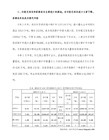
Hawkes’ version: Even the cleverest housewife can't cook bread without flour.
However, that is not to say that the Yangs will always keep to a foreignizating translation or Hawkes’ will stick to strict domestication all the time. In fact, they take diferent methods according to their needs and purposes.
异化与归化的英语作文

异化与归化的英语作文Title: Exploring Alienation and Domestication inCultural Translation。
Cultural translation involves a delicate balance between alienation and domestication, two concepts thatplay pivotal roles in conveying the essence of a text from one language and culture to another. In this essay, wedelve into the nuanced interplay between these concepts and their implications for effective translation.Alienation, in the context of translation, refers tothe preservation of foreignness or otherness in the target text. It involves maintaining elements of the sourceculture and language that may be unfamiliar or exotic tothe target audience. When translators prioritize alienation, they aim to challenge the reader's assumptions and broaden their cultural horizons. By preserving linguistic quirks, idiomatic expressions, and cultural references unique tothe source text, translators evoke a sense of the foreignand encourage readers to engage with unfamiliar perspectives.For example, in translating a Japanese haiku into English, a translator might retain the syllabic structure and minimalist style of the original poem, thereby preserving its distinct cultural flavor. By resisting the temptation to domesticize the text, the translator invites readers to appreciate the beauty and simplicity of Japanese poetic tradition, even if it means sacrificing some degree of accessibility.On the other hand, domestication involves adapting the source text to make it more familiar and accessible to the target audience. Translators who prioritize domestication prioritize clarity and readability over strict adherence to the original text's form and content. This approach often involves replacing culturally specific references with equivalents that resonate with the target audience, as well as adjusting syntax and style to conform to the conventions of the target language.For instance, when translating a French novel into English, a translator might replace French cultural references with their English counterparts to ensure that readers can relate more easily to the text. By domesticating the language and content, the translator minimizes potential barriers to understanding and creates a sense of immediacy and relevance for the target audience.However, the dichotomy between alienation and domestication is not always clear-cut, and translators often navigate a continuum between these two poles depending on the demands of the text and the preferences of the target audience. In practice, most translations involve a combination of both strategies, with translators striking a balance between preserving the integrity of the source text and making it accessible to a new audience.Moreover, the choice between alienation and domestication is influenced by various factors, including the genre of the source text, the intended audience, and the translator's own interpretation of the text's meaning and significance. While some texts may lend themselves to amore alienating approach, others may benefit from a greater degree of domestication to ensure widespread appeal and understanding.In conclusion, the concepts of alienation and domestication represent two complementary strategies in the practice of cultural translation. By navigating the tension between preserving the integrity of the source text and making it accessible to a new audience, translators play a crucial role in bridging linguistic and cultural dividesand fostering cross-cultural understanding and appreciation. As such, an effective translation requires careful consideration of both alienation and domestication, as well as a nuanced understanding of the cultural dynamics at play.。
英语论文 归化与异化翻译

2010届本科生毕业设计(论文)毕业论文Domestication orForeignism-oriented Skills inTranslation学院:外国语学院专业:姓名:指导老师:英语专业xx 学号:职称:xx 译审中国·珠海二○一○年五月xx海学院毕业论文诚信承诺书本人郑重承诺:我所呈交的毕业论文Domestication or Foreignism-oriented Skills in Translation是在指导教师的指导下,独立开展研究取得的成果,文中引用他人的观点和材料,均在文后按顺序列出其参考文献,论文使用的数据真实可靠。
承诺人签名:日期:年月日Domestication or Foreignism-oriented Skills in TranslationABSTRACTTranslation, a bridge between different languages and cultures, plays an indispensable role in cross-culture communication. However, as a translator, we have to choose which strategy to deal with the cultural differences between the source language and the target language in the process of translation where there exists two major translation strategies--- domestication and foreignization. In this thesis, I will discuss these strategies and their application from translation, linguistics, and cross-cultural communication perspectives.In the thesis, I will first talk about the current research of the domestication and foreignization in the translation circle as well as point out the necessity for further research. Then, I will illustrate the relationship between linguistics and translation as well as between culture and translating and next systematically discuss these two translation strategies including their definitions, the controversy in history and their current studies.Besides, I will continue to deal with such neglected factors as may influence the translator’s choice of translation strategies: the type of the source text (ST), the translation purposes, the level of the intended readers, the social and historical background, the translator’s attitude and so on. Finally, from the linguistic and cultural perspectives, the thesis makes a comparative study of the application of domestication and foreignization by analyzing typical examples from the two English versions of Hong Lou Meng translated by Yang Xianyi and David Hawkes respectively.The thesis will conclude that these two translation strategies have their respective features and applicable value. I sincerely hope that this research into translation strategies will enlighten translators and make a little contribution to the prosperity oftranslation studies and translation practice in China.Key words: translation strategy; domestication; foreignization; application归化与异化翻译摘要翻译作为沟通不同语言与文化的桥梁,在跨文化交际中起着不可或缺的作用。
【参考文档】归化与异化-推荐word版 (8页)
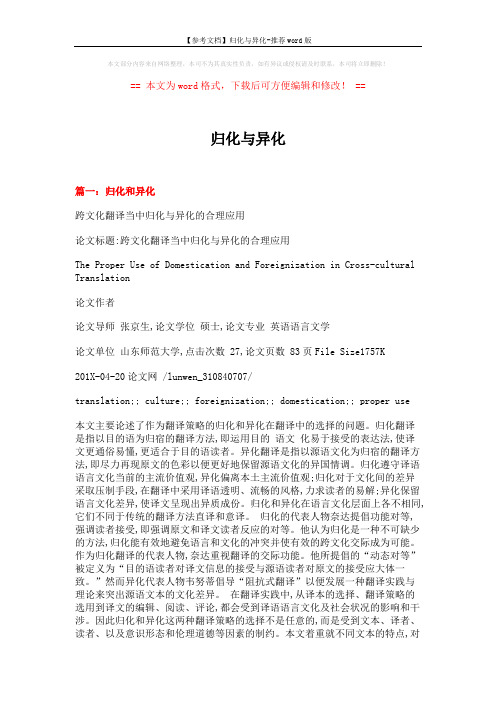
本文部分内容来自网络整理,本司不为其真实性负责,如有异议或侵权请及时联系,本司将立即删除!== 本文为word格式,下载后可方便编辑和修改! ==归化与异化篇一:归化和异化跨文化翻译当中归化与异化的合理应用论文标题:跨文化翻译当中归化与异化的合理应用The Proper Use of Domestication and Foreignization in Cross-cultural Translation论文作者论文导师张京生,论文学位硕士,论文专业英语语言文学论文单位山东师范大学,点击次数 27,论文页数 83页File Size1757K201X-04-20论文网 /lunwen_310840707/translation;; culture;; foreignization;; domestication;; proper use本文主要论述了作为翻译策略的归化和异化在翻译中的选择的问题。
归化翻译是指以目的语为归宿的翻译方法,即运用目的语文化易于接受的表达法,使译文更通俗易懂,更适合于目的语读者。
异化翻译是指以源语文化为归宿的翻译方法,即尽力再现原文的色彩以便更好地保留源语文化的异国情调。
归化遵守译语语言文化当前的主流价值观,异化偏离本土主流价值观;归化对于文化间的差异采取压制手段,在翻译中采用译语透明、流畅的风格,力求读者的易解;异化保留语言文化差异,使译文呈现出异质成份。
归化和异化在语言文化层面上各不相同,它们不同于传统的翻译方法直译和意译。
归化的代表人物奈达提倡功能对等,强调读者接受,即强调原文和译文读者反应的对等。
他认为归化是一种不可缺少的方法,归化能有效地避免语言和文化的冲突并使有效的跨文化交际成为可能。
作为归化翻译的代表人物,奈达重视翻译的交际功能。
他所提倡的“动态对等”被定义为“目的语读者对译文信息的接受与源语读者对原文的接受应大体一致。
”然而异化代表人物韦努蒂倡导“阻抗式翻译”以便发展一种翻译实践与理论来突出源语文本的文化差异。
foreignization
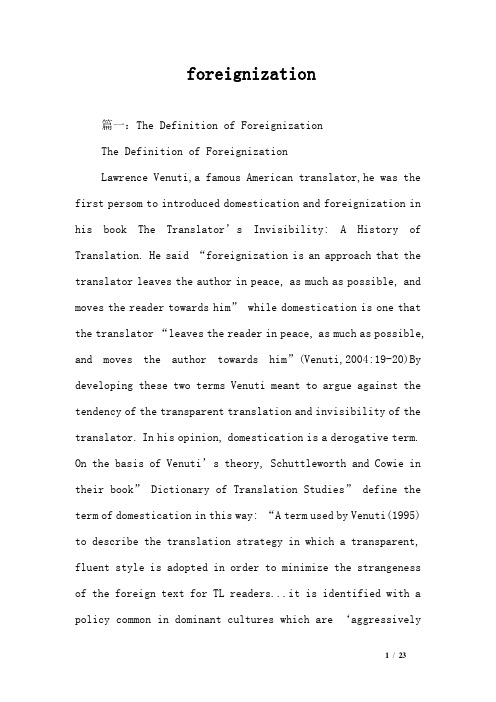
foreignization篇一:The Definition of ForeignizationThe Definition of ForeignizationLawrence Venuti,a famous American translator,he was the first persom to introduced domestication and foreignization in his book The Translator’s Invisibility: A History of Translation. He said “foreignization is an approach that the translator leaves the author in peace, as much as possible, and moves the reader towards him” while domestication is one that the translator “leaves the reader in peace, as much as possible, and moves the author towards him”(Venuti,2004:19-20)By developing these two terms Venuti meant to argue against the tendency of the transparent translation and invisibility of the translator. In his opinion, domestication is a derogative term. On the basis of Venuti’s theory, Schuttleworth and Cowie in their book” Dictionary of Translation Studies” define the term of domestication in this way: “A term used by Venuti(1995) to describe the translation strategy in which a transparent, fluent style is adopted in order to minimize the strangeness of the foreign text for TL readers...it is identified with a policy common in dominant cultures which are ‘aggressivelymonolingual, ueceptive to the foreign’, and which he describes as being’ accustomed to fluent translations that invisibly inscribe foreign text with[target language] values and provide readers with narcissistic experience of recognizing their own culture in a cultural other’.(Schuttleworth&Cowie,2004:43-44) Foreignizing translation in which a TT is produced which deliberately breaks target conventions by retaining something of the foreignness of the original.”(Schuttleworth&Cowie,2004:59) Venuti regarded foreignizing translation as a challenge towards domestication and the function is to “register the linguistic and cultural difference of the foreign text, sending the reader abroad.”(Venuti,2004:20) In translation, domestication means removing all strangeness and foreignness of the source text and making the translation read like the original. Domestication is oriented towards the target language. Foreignization is the opposite approach and by applying this method the foreignness of the source language will be kept to the greatest possible extent篇二:劳伦斯·韦努蒂一.劳伦斯·韦努蒂的基本信息及其主张:劳伦斯·韦努蒂 Lawrence Venuti(1953年—)学者,大学英语教授,专职翻译家,美籍意大利人,生于费城南部(此区域居住者多为意大利裔),七十年代早期在天普大学攻读英语文学,1980年获哥伦比亚大学博士学位。
伦理视角下翻译的异化和归化_英语专业毕业论文

伦理视角下翻译的异化和归化_英语专业毕业论文论文导读::并引入翻译学研究中。
首次提出“异化”和“归化”两个概念。
归化翻译是一种为了适应本国的价值取向或本国读者群体。
异化翻译是一种保持原有的“异国情调”和道德伦理价值。
论文关键词:翻译,异化,归化,伦理1、引言劳伦斯韦努蒂(Lawrence Venuti, 1953~)美籍意大利学者,首次提出“异化”和“归化”两个概念,并引入翻译学研究中。
异化翻译是一种保持原有的“异国情调”和道德伦理价值,风俗或习惯,尽量贴近原作者的写作目的,以及所在国家的意识形态等。
归化翻译是一种为了适应本国的价值取向或本国读者群体,而采用一种符合本国的意识形态和伦理价值观,尽量使用本国的通俗易懂的本国语言的表达方式翻译外来作品,往往这些国家在经济、政治或军事上处于霸权地位,导致文化上也处于权利优势。
这在20世纪初尤为明显,当时英美国家使用的英语语言处于话语霸权的位置,所以在全世界范围来看,从外文译成英文书籍数量之少,简直和英语译入外文的书籍无法媲美,只能是望尘莫及。
这就体现出翻译中的文化霸权地位和话语权利的问题。
而在西方一些发达国家,在翻译外文时采取归化翻译策略,目的就是体现出本国的价值观和伦理观,让英语处于绝对的优势地位,体现的是一种“民族中心主义”。
一个国家、一个民族甚至一个译者,在不同时期为了不同的目的会采取不同的翻译策略,异化或归化的翻译策略就是最好的例证。
2、翻译与伦理的关系伦理何为?“伦理”一词在中西方出现的时间各不相同。
从英文词源来看,ethics来自希腊文ethos,是品性、品格以及风俗习惯的意思,内在意义是关于人的行为规范和原则等。
直到公元前4世纪,伟大的哲学家亚里士多德创立了研究道德品行的学问英语专业毕业论文,称之为伦理学。
后来,西方伦理学看作哲学的一个分支,并加以科学化,主要研究探讨什么是好的善的,什么是坏的恶的,及关于一个人的行为是正确的或错误的一个道德标准。
翻译中的归化与异化——以《文化透视英语教程》为例

分类号学校代码!鳗鲤密级学号-20-**********翻译中的归化与异化——以《文化透视英语教程》为例DomesticationandForeignizationinrnllranslatlon-·--AcasestudyofEnglishThroughCulture指导教师姓名、职称直鎏塑塾撞湖南师范大学学位评定委员会办公室二0一一年五月’一一一DomesticationandF0relgnlZatlonln,-nlranSIatlon--·-AcasestudyofEnglishThroughCultureA砀esisSubmittedtoForeignStudiesCollegeOfHunanNormalUniversityInPartialFulfillmentoftheRequirementsForTheDegreeofMasterofTranslationandInterpretingByYangLuUndertheSupervisionofProfessorXiaoYunchuChangsha,HunanMay,2011摘要语言是文化的载体,而翻译将两种语言相互转换,传递文化信息,与文化密不可分。
作为文化传递的桥梁,译文既要能被目的语读者接受,又要能传递源语文化。
这种文化的转化引起了归化与异化之争。
在跨文化翻译中,归化与异化各有长短,翻译时应慎重考虑。
归化翻译强调译者应该打破文化间的障碍,避免文化冲突,使译文能被读者接受。
异化翻译强调译文要重现源语语言文化,为读者呈现原汁原味的异域风情和语言风格。
本文主要从三个部分来阐述归化与异化的发展问题:第一部分主要介绍归化和异化问题的由来以及两者的内涵;第二部分主要论述归化和异化在使用时是如何对立统一的;第三部分从翻译实践出发(以英译汉为主),举例说明了归化和异化的具体应用方法;最后得出结论:在跨文化翻译中,归化和异化不是完全对立的,而是相辅相成,相互融合的。
浅谈跨文化翻译中的异化和归化

公关论坛浅谈跨文化翻译中的异化和归化文/王琪摘要:在各个国家联系日趋紧密的今天,翻译对促进各国的交流和发展起到了重要的作用。
它不仅涉及语言问题,也涉及文化问题。
在处理源语文化和目的语文化差异的过程中,就产生了两种重要的翻译方法。
归化法(Domesticating Method)和异化法(Foreignizing Method),选择哪种翻译方法是由作者意图、读者对象、文化等多方面因素决定的。
归化法和异化法是相辅相成、不可分割的,在实践中使用哪一种方法还是将二者结合起来,应该根据上下文具体问题具体分析。
本论文通过对归化和异化翻译策略的深入探讨,以期让翻译工作者更深入了解两种重要的翻译理论,为日后的翻译实践活动提供帮助。
在国与国之间架起沟通的桥梁,促进国与国文化的交流互鉴。
关键词:归化法;异化法;跨文化交际;源语文化;目的语文化引言随着全球化进程的不断加快,世界各地的联系日趋紧密,在当今这个跨文化交流日趋频繁的时代,翻译对实现各民族的融合、交流与发展起到了重要的作用。
翻译工作已经不再是两种语言符号的转换,而是一种跨文化交际。
语言和文化是相互依赖、相互影响的,语言是文化的重要载体,文化的传播必须借助语言这个媒介;文化对语言起到了制约的作用,不同地区的文化下,人们的语言表达方式不同。
英语与汉语各自隶属于不同的语系,英语属于印欧语系(Indo-European Language),汉语属于汉藏语系(Sino-Tibetan Language)。
英汉两种语言在词法、句法甚至篇章结构等方面存在明显的差异。
要完成读者能够理解,又能体会到其中文化特征的英汉跨文化翻译是一项相对来讲比较困难的工作,很多来自不同社会文化背景的翻译工作者,从不同的角度探讨了跨文化交际的问题,提出了不同的翻译策略和方法。
归化和异化是翻译研究中一对非常重要的范畴。
熟练掌握归化与异化翻译策略,对于开展国际交流、文化输出等大有益处。
一、何为翻译的“归化”和“异化”翻译与文化密切相关,一般而言,可以分成两种对立的看法,即归化法(Domesticating Method)和异化法(Foreignizing Method)这两种原则和方法。
归化与异化
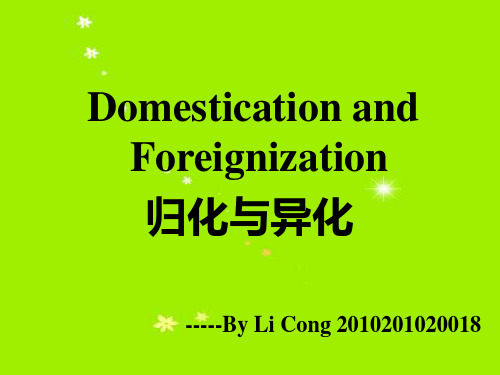
Some foreignization instances:
• 森格: 如果巴特尔救不活,我再回来收拾你。 Sen’ge: If Bater doesn’t live, I’m coming back to fix you up. • 图雅:把死当成个本事了是不是?要死我早死了。 还轮的上你来抢这个头功! Tuya: You think dying is some great skill, is that it? If I could I’d have already done it. But now you want to snatch the prize!
余曰‚卿果中道相舍, 断无再续之理。况‘曾经 沧海难为水, 除却巫山不是云’耳‛!
“Even if you should leave me half - way like this,” I said, “I shall never marry again. Besides, it is difficult to be water for one who has seen the great seas, and difficult to be clouds for one who has seen the Yangtze Gorges.” (foreignization)
Film Subtitle Translation
The characteristics of film subtitle translation :
comprehensive instantaneous oral
The choice of tanslation strategies in film subtitle translation:
For commercial and other considerations, domestication is more chosen in the English translation of Chinese film subtitles.
(英语系毕业论文)西游记神话人物称谓翻译策略:归化与异化
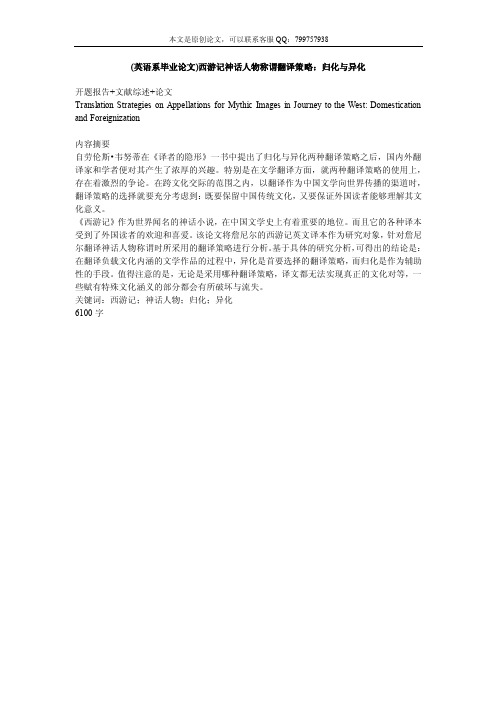
本文是原创论文,可以联系客服QQ:799757938
(英语系毕业论文)西游记神话人物称谓翻译策略:归化与异化
开题报告+文献综述+论文
Translation Strategies on Appellations for Mythic Images in Journey to the West: Domestication and Foreignization
内容摘要
自劳伦斯•韦努蒂在《译者的隐形》一书中提出了归化与异化两种翻译策略之后,国内外翻译家和学者便对其产生了浓厚的兴趣。
特别是在文学翻译方面,就两种翻译策略的使用上,存在着激烈的争论。
在跨文化交际的范围之内,以翻译作为中国文学向世界传播的渠道时,翻译策略的选择就要充分考虑到:既要保留中国传统文化,又要保证外国读者能够理解其文化意义。
《西游记》作为世界闻名的神话小说,在中国文学史上有着重要的地位。
而且它的各种译本受到了外国读者的欢迎和喜爱。
该论文将詹尼尔的西游记英文译本作为研究对象,针对詹尼尔翻译神话人物称谓时所采用的翻译策略进行分析。
基于具体的研究分析,可得出的结论是:在翻译负载文化内涵的文学作品的过程中,异化是首要选择的翻译策略,而归化是作为辅助性的手段。
值得注意的是,无论是采用哪种翻译策略,译文都无法实现真正的文化对等,一些赋有特殊文化涵义的部分都会有所破坏与流失。
关键词:西游记;神话人物;归化;异化
6100字。
归化和异化翻译理论论文(英语版)
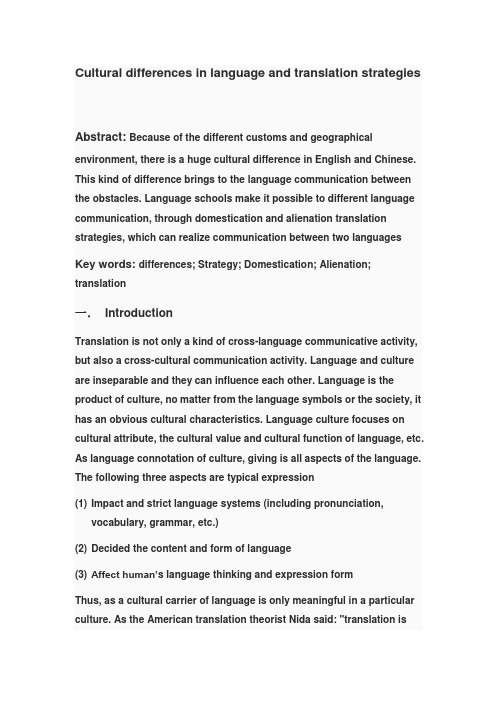
Cultural differences in language and translation strategiesAbstract:Because of the different customs and geographical environment, there is a huge cultural difference in English and Chinese. This kind of difference brings to the language communication between the obstacles. Language schools make it possible to different language communication, through domestication and alienation translation strategies, which can realize communication between two languagesKey words: differences; Strategy; Domestication; Alienation; translation一.IntroductionTranslation is not only a kind of cross-language communicative activity, but also a cross-cultural communication activity. Language and culture are inseparable and they can influence each other. Language is the product of culture, no matter from the language symbols or the society, it has an obvious cultural characteristics. Language culture focuses on cultural attribute, the cultural value and cultural function of language, etc. As language connotation of culture, giving is all aspects of the language. The following three aspects are typical expression(1) Impact and strict language systems (including pronunciation,vocabulary, grammar, etc.)(2) Decided the content and form of language(3) Affect human’s language thinking and expression formThus, as a cultural carrier of language is only meaningful in a particular culture. As the American translation theorist Nida said: "translation isthe communication between the two cultures. For truly successful translating, familiar with two cultures is even more important than to master two languages.” there is a huge difference in Chinese-English nationality values, beliefs, customs, historical background, geographical conditions, social system, life experience, etc. This difference not only imprint their respective language but also bring many difficulties for the mutual translation between the two languages. This article start from the cultural differences of Chinese-English, try to seek the cultural equivalence translation by domestication and alienation.二.cultural differences between Chinese-EnglishBecause language is a product of culture and the social, we should understand it from the perspective of cultural and social. Chinese culture emphasize the "value theory" while English advocating "personal value supremacy". Besides values differences, Chinese-English cultural differences there are geographical environment and social environment, climate conditions and customs, etc.(一) cultural differences caused by geographicalenvironmentThere is a regional culture. Special geographical environment and climate characteristics of the skin often give the region culture. Britain is the island, located in the western hemisphere, north temperate zone, oceanic climate, so its language reflect the geographical characteristics. For example: spend money like water; make water; all at sea. While China is located in mainland Asia, Chinese say “spend money like earth”As for the different climate lead to the different culture is also numerous. For example “Dongfeng” in China is the symbol of harvest, while “West Wind” replaces it in west countries.(二) cultural differences caused by CustomsChinese-English cultural differences caused by customs is obvious on animal vocabulary. British culture is the typical "Ma Wenhua", such as talk horse, get on one’s high horse,horse and horse etc. However, Chinese a "NiuWenHua".三.Translation and StrategiesDomestication and alienation into China, many researchers raised their opinions on the two translation strategies. In 1987, an academic paper entitled “Domestication: The Wrong Track in Translation” by Liu Yingkai aroused the first round of dispute on domestication and alienation. In 1995, Weihui Reading Weekly and Foreign Languages School of Nanjing University organized a survey of readers, responses to different versions of the French novel Scarlet and Black, which gave rise to a debate on many translation issues, including domestication and alienation . Domestication and alienation serve as two major translation strategies. The two terms originated from German theologician and philosopher, Friedrich Schleiermacher’s lecture. Later on, Venuti (1995) explained the two terms. According to Venuti, domestication is the dominating translation strategy in Anglo-American culture. Employment of domestication brings the original text and author to the target text readers, erasing the linguistic and cultural differences and making the original text conform to the current dominant linguistic characteristics and values in the target-language culture. Alienation was coined by Venuti to resist domestication. Application of alienation brings the target language readers to the original author and the original text, keeping the original linguistic and cultural differences and even attempting to find differences. We may realize alienation by using non-standarddiscourse or choosing to translate a text that challenges the contemporary canon.Reference:[1]Nida, Eugene A. Language, Culture and Translating. Shanghai Foreign Language Education Press. 1993:105-115.[2]赵爱国.语言文化学论纲[M].黑龙江人民出版社,2006:28-41.屈小楠,李春晓,冉小桃,徐相舒。
归化与异化
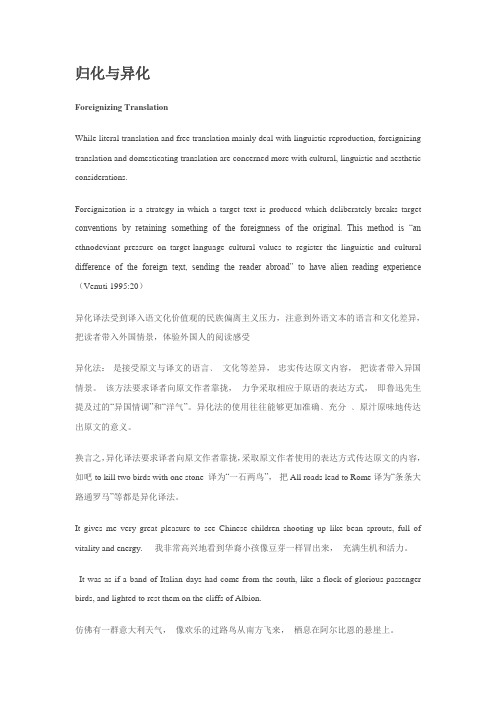
归化与异化Foreignizing TranslationWhile literal translation and free translation mainly deal with linguistic reproduction, foreignizing translation and domesticating translation are concerned more with cultural, linguistic and aesthetic considerations.Foreignization is a strategy in which a target text is produced which deliberately breaks target conventions by retaining something of the foreignness of the original. This method is “an ethnodeviant pressure on target-language cultural values to register the linguistic and cultural difference of the foreign text, sending the reader abroad” to have alien reading experience (Venuti 1995:20)异化译法受到译入语文化价值观的民族偏离主义压力,注意到外语文本的语言和文化差异,把读者带入外国情景,体验外国人的阅读感受异化法:是接受原文与译文的语言﹑文化等差异,忠实传达原文内容,把读者带入异国情景。
该方法要求译者向原文作者靠拢,力争采取相应于原语的表达方式,即鲁迅先生提及过的“异国情调”和“洋气”。
异化法的使用往往能够更加准确﹑充分﹑原汁原味地传达出原文的意义。
翻译的归化与异化论文

异化和归化双重翻译策略》——结合文本翻译《飘》关键字:归化、异化、双重策略《飘》摘要:《飘》(Gone with the Wind)是美国著名女小说家玛格丽特·米西尔(Margaret Mitchell)的成名作,于1936年出版后第一年就销售2000万册,并于1937年获普利策奖。
故事以美国南北战争为背景,是一部带有感伤怀旧情绪的爱情小说。
傅东华在1940年将《飘》译成汉语。
傅译本的《飘》用词简单平实,语言流畅熟悉。
傅译本的《飘》就像中国小说,读起来毫无生涩、泊来之感。
傅译本的这种风格主要是由大量使用归化翻译手法产生的。
本文拟总结并例示其归化和异化的内容,探讨其采用归化和异化翻译规律。
一、简述中国翻译界存在的两派之争的发展。
1中国的翻译界一直以来存在着两派之争,从第一次翻译高潮时佛经翻译的“文”与“质”之争,到近代“直译”与“意译”之争,及至当代的“异化”与“归化”之间的大讨论。
中国的文学翻译是从晚清时期的19 世纪70 年代开始的,迄今只有100多年历史。
纵观19 世纪70 代到20 世纪70 年代这一百年期间,中国文学翻译界基本上以归化为主调,1987 年,刘英凯[1]在《现代外语》上发表了《归化———翻译的歧路》,从而引发了学界对归化和异化问题的重新思考,并展开了激烈的讨论。
在不断的深入探讨和研究之后,异化开始逐渐占据上风。
孙致礼认为,“21 世纪的中国文学翻译,将进一步趋向异化译法”。
在一片异化的呼声当中,蔡平提出了截然不同的观点,认为“翻译方法应以归化为主”。
两派在争论当中,在主张一方的同时,当然也并不否定另一方的存在。
主要分歧存在于两点,一是对于归化和异化概念的界定,二是双方中究竟谁起主导作用。
2美国女作家玛格丽特·米切尔的长篇小说Gone with the Wind 自问世以来, 一直畅销不衰, 至今汉译本大约已超过7 个。
其中傅东华先生所译之《飘》是最早的一个, 也是受到争议最多的一个。
(全英文论文)归化与异化在影视字幕翻译中的应用-绝望的主妇为例

原创毕业论文公布的题目可以用于免费参考(全英文论文)从中美非语言差异看国际商务谈判的影响及其对策(全英文论文)珍妮的悲剧(全英文论文)奥巴马就职演讲的修辞分析(全英文论文)英语专业教育实习调查研究(全英文论文)论推销员之死中美国梦(全英文论文)输入强化和篇章背诵教学方法对比研究(全英文论文)初中英语口语教学中如何提高学生参与度(全英文论文)大学生英语学习焦虑现状调查、分析及对策(全英文论文)从英汉征婚广告对比中浅析中美文化差异(全英文论文)外语词汇磨蚀及对外语教学的启示(全英文论文)大学生基督教信仰问题的调查报告(全英文论文)中英文化视角下颜色词黑白的翻译(全英文论文)浅析我国中小企业电子商务现状与对策(全英文论文)汉英翻译名词化形式分析(全英文论文)推销员之死中威利•洛曼的悲剧命运成因分析(全英文论文)礼仪在商务谈判中的作用(全英文论文)英语歧义现象研究(全英文论文)从个人主义的角度解读鲁滨逊的成功(全英文论文)探索E.B.怀特的夏洛的网(全英文论文)影响中学生英语听力的因素本题目是全英文原创论文,需要完整可以联系QQ:805 99 0749 (全英文论文)英文原版电影在英语口语学习中的应用(全英文论文)外交辞令中模糊策略的应用(全英文论文)英汉动物习语文化差异的原因分析(全英文论文)中美英雄主义文化的对比研究-以叶问和蝙蝠侠为例(全英文论文)合作学习法对英语口语能力的影响(全英文论文)浅析中式英语中的翻译逻辑(全英文论文)分析托尔金魔戒中女性形象(全英文论文)中国特色词汇在对外宣传中的翻译策略(全英文论文)庞德的长干行译本与原作的意境差异及其文化根源研究_英语论(全英文论文)中国女大学生奢侈品消费动机探析(全英文论文)影响学生阅读的主要障碍及其解决策略(全英文论文)论英语广告中的仿拟(全英文论文)公益广告翻译的功能对等(全英文论文)浅谈跨文化交际中的非语言交际(全英文论文)论弗兰肯斯坦中的性别隐喻(全英文论文)文化碰撞交融-对比元杂剧赵氏孤儿与伏尔泰中国孤儿(全英文论文)第二次世界大战中的温斯顿.丘吉尔(全英文论文)浅析热爱生命中的永不放弃精神(全英文论文)自我修正在英语本族语者的学术讨论中的使用研究(全英文论文)低调陈述的交际功能(全英文论文)对圣经文学性之赏析(全英文论文)英语语调在英语辩论赛中的作用及把握(全英文论文)论英文歌词的汉译(全英文论文)分析中学英语写作问题与方法(全英文论文)从心理角度浅谈丁克家庭在中国出现的原因(全英文论文)小公主中萨拉的人格魅力及其影响(全英文论文)呼啸山庄中凯瑟琳自我矛盾的爱(全英文论文)外资银行进入中国带来的机遇与挑战(全英文论文)关联理论视角下英语幽默的汉译策略研究--老友记对白为例(全英文论文)英语专业一年级大学生词汇学习策略调查(全英文论文)大学英语课堂中模糊限制语的使用及其语用功能(全英文论文)到灯塔去中的莉丽.布里斯科的艺术价值(全英文论文)浅析凯特肖邦短篇小说中的女性意识(全英文论文)论美国文化的霸权(全英文论文)非英语专业大学生英语学习动机的调查与分析(全英文论文)非英语专业大学生英语作文中的时态错误分析(全英文论文)狮子,女巫和魔衣橱中的魔幻与现实(全英文论文)央视公益广告互动意义的多模态话语分析(全英文论文)浅论英美影视字幕翻译方法(全英文论文)谈如何改善师生关系(全英文论文)论鲁滨逊漂流记中的社会现实(全英文论文)棺材里开出的人性之花(全英文论文)独立学院英语专业大一学生阅读策略使用情况调查与分析(全英文论文)从奥巴马连任看美国黑人历史地位的变迁(全英文论文)中美面部表情之文化差异(全英文论文)如何提高性格内向中学生的口语(全英文论文)体态语在初中英语教学中的应用(全英文论文)旅游文本翻译中的文化元素的处理(全英文论文)研究中西节日文化的差异(全英文论文)广告英语的词汇特征(全英文论文)汉语政治新词英译原则及策略(全英文论文)论英汉汉英交替传译中的翻译技巧(全英文论文)小班化教学在初中英语教学中的作用(全英文论文)从功能目的论看美国电影字幕翻译-录取通知为例(全英文论文)文化差异对于汽车品牌翻译的影响(全英文论文)简析了不起的盖茨比中的三位女性代表(全英文论文)英汉颜色词的比较和翻译(全英文论文)美学视角下的林语堂翻译研究-扬州瘦马为例(全英文论文)如何提高小学生英语学习动机(全英文论文)浅析百年孤独的环境宿命论(全英文论文)汉英礼貌原则对比浅析(全英文论文)英汉语言中红色联想意义的比较(全英文论文)农村初中生学习动机对英语成绩两极分化的影响XX中学为例(全英文论文)道连.格雷的画像中亨利的人物形象分析(全英文论文)英语习语的起源及其特点(全英文论文)分析傲慢与偏见中伊丽莎白和卢卡斯的婚姻观(全英文论文)顽强的生命之歌-解读杰克•伦敦的热爱生命(全英文论文)英文广告翻译策略研究(全英文论文)中西方餐桌礼仪的文化差异(全英文论文)分析翻译中的情感缺失问题(全英文论文)高中英语教学过程中实施情感教育的研究(全英文论文)合作原则视角下的外贸函电翻译(全英文论文)荷马史诗中阿喀琉斯形象的分析(全英文论文)从语境理论角度分析奥巴马就职演说词语篇(全英文论文)语法教学失效原因分析(全英文论文)对边疆地区高中生英语学习观念的调查与分析—XX中学为例(全英文论文)非英语专业学生听力学习调查与培养策略(全英文论文)英语专业学生网络自主学习情况调查与分析(全英文论文)海明威笔下的另类英雄艾略特夫妇和雨中的猫中的男性形象。
- 1、下载文档前请自行甄别文档内容的完整性,平台不提供额外的编辑、内容补充、找答案等附加服务。
- 2、"仅部分预览"的文档,不可在线预览部分如存在完整性等问题,可反馈申请退款(可完整预览的文档不适用该条件!)。
- 3、如文档侵犯您的权益,请联系客服反馈,我们会尽快为您处理(人工客服工作时间:9:00-18:30)。
Domestication and Foreignization:A Case Study Of Selected Modern Chinese Essays Renderedby Zhang PeijiAbstractDomestication and foreignization are widely applied as two major translation strategies. Also, as an academic issue, they are discussed with ardent interest by scholars at home and abroad. As scholars hold different opinions about theirapplication, the author believes that the two strategies are worth studying further. The author concludes that domestication is much more frequently employed and foreignization functions as a complementary strategy in Zhang’s translated works, and that domestication can be reasonably applied as the dominating translation strategy, and foreignization may be effectively used to translate cultural elements, which is especially true of translation of Chinese essays into English. It is sincerely hoped that this thesis will enlighten translators and help them flexibly utilize translation strategies so that they may do better in translation.Key words: translation strategies, domestication, foreignization, a case studyChapter One Introduction1.1 Necessity and Significance of This StudySince translation appeared, research on translation strategies has never ceased. As two translation strategies, domestication and foreignization have aroused intense discussions since they were put forward by Lawrence V enuti. Many researchers have raised their opinions on domestication and foreignization.But there are still problems. This thesis not only presents a relatively comprehensive study of domestication and foreignization, but also provides a case study of Selected Modern Chinese Essays translated into English by Professor Zhang Peiji so as to show how domestication and foreignization are flexibly employed in translation practice and to prove which is the dominating translation strategy and which is the supplementary one.1.2 Research MethodologyThe major methods used in this thesis are as follows: (1) the descriptive approach;(2) the comparative-study approach; (3) the case-study method; (4) the qualitative-analysis method; (5) the quantitative-analysis method. All the examples have been carefully selected from the two volumes of Selected Modern Chinese Essays Rendered Into English by Zhang Peiji.1.3 Organization of the ThesisThis thesis is composed of four parts,Chapter One first explains the necessity and significance of this research, then it states the research methodology and the organization of this thesis.Chapter Two presents a brief review of major studies on domestication and foreignization at home and abroad. Chapter Three carries out a case study of Professor Zhang’s two volumes of Selected Modern Chinese Essays Rendered Into English to show how domestication and foreignization are employed in translation practice.Chapter Four serves as the conclusion. This chapter summarizes the main points.Chapter Two Literature ReviewThis chapter first reviews major studies on foreignization and domestication abroad, then it overviews main studies of the two translation strategies in China.2.1 Studies on Foreignization and Domestication AbroadInitial studies on domestication and foreignization in the West can be traced back to Friedrich Schleiermacher, a German theologician and philosopher. In 1813 in his essay entitled“On the Different Methods of Translation”, Schleiermacheremphasized that there were two paths in translation.Eugene Nida is an influential advocator of domestication, who focuses on the communicative function of translation. He put forward dynamic equivalence, which means that the receptors of the message in the receptor language respond to it in the same manner as the receptors in the source language (N ida, 1964:166).2.2 Studies on Foreignization and Domestication in ChinaWith the introduction of domestication and foreignization into China, many researchers raised their opinions on the two translation strategies.In 1987, an academic paper entitled “Domestication: The Wrong Track in Translation”by Liu Yingkai aroused the first round of dispute on domestication and foreignization.In 1995, Weihui Reading Weekly and Foreign Languages School of Nanjing University organized a survey of readers’responses to different versions of the French novel Scarlet and Black, which gave rise to a debate on many translation issues, including domestication and foreignization.Chapter ThreeA Case Study of Selected Modern Chinese Essays Rendered Into English by Zhang Peiji from the Perspective of Domestication and ForeignizationAs Chinese and English are two different languages, different words are always employed to express the same meaning. For example, “红茶”in Chinese has the same meaning as “black tea”in English. Even the same word or expression may have different meanings. For example, “龙”is a positive word in Chinese while the word“dragon”is often connected with evils and considered as negative in Western culture.In translation, we should consider such lexical differences and choose different translation strategies accordingly. Take “亚洲四小龙”, a Chinese phrase, as anexample. “亚洲四小龙”refers to the four regions with a booming economy ––Hongkong, Taiwan, Singapore, and Korea. The translation of “亚洲四小龙”into “four tigers in Asia”, an equivalent phrase in English, may be considered as an instance handled by means of domestication.Chinese does show a linguistic phenomenon that four-character phrases are often employed. Obviously, frequent use of domestication helps to express their meaning, and enables target readers to understand the corresponding versions better, and thus Chinese essays can be introduced into Western countries more easily. But as we know, everything is divided into two. Frequent use of domestication affects the spread of Chinese characteristics. When Western readers read English versions of four-character expressions, they may not realize their ubiquitous existence in Chinese. However, as numerous Westerners have learned or are learning Chinese, this particular Chinese feature has become known or will be familiar to more and more Westerners.Chapter Four ConclusionDomestication and foreignization serve as two major translation strategies. The two terms originated from German theologician and philosopher, Friedrich Schleiermacher’s lecture. Later on, V enuti (1995) explained the two terms. According to V enuti, domestication is the dominating translation strategy in Anglo-American culture. Employment of domestication brings the original text and author to the target text readers, erasing the linguistic and cultural differences and making the original text conform to the current dominant linguistic characteristics and values in the target-language culture. Foreignization was coined by V enuti to resist domestication. Application of foreignization brings the target language readers to the original author and the original text, keeping the original linguistic and cultural differences and even attempting to find differences. We may realize foreignization by using non-standard discourse or choosing to translate a text that challenges the contemporary canon.Bibliography[1] Bassnett, Susan. Translation Studies[M]. Shanghai: Shanghai Foreign LanguageEducation Press, 2004.[2] Bassnett, Susan & Andre Lefevere. Constructing Cultures: Essays on LiteraryTranslation[C]. Shanghai: Shanghai Foreign Language Education Press, 2001. [3] Beaugrander, D. & Wolfgang U. Dressler. Introduction to Text Linguistics[M], New Y ork: Longman Inc, 1981.[4] Cuddon, J. A. A Dictionary of Literary Terms[Z]. Chatham: W&J Mackay Limited, 1979.[5] Gentzler, Edwin. Contemporary Translation Theories[M]. Shanghai: Shanghai Foreign Language Education Press, 2004.09翻译三班徐兵(0902421087)。
